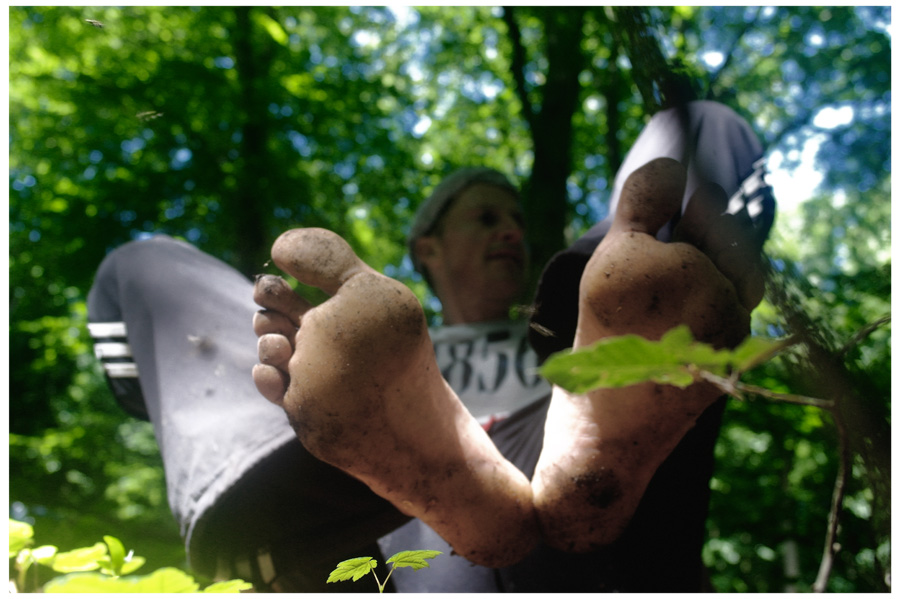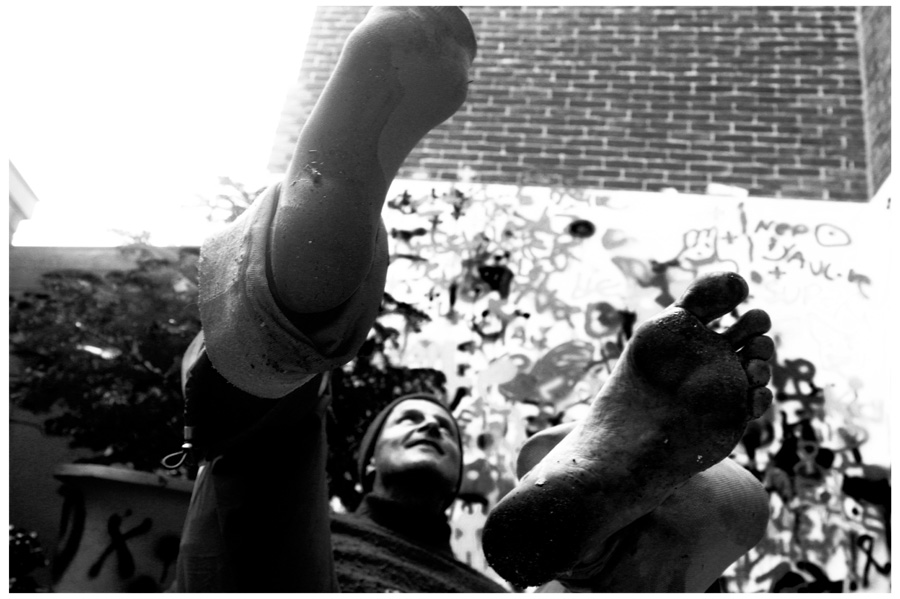SAR_prologue
- Details
- Hits: 7991

Above: FP SAR 30K-BL-training. Sar training: Peal it off, adjust the parts and reassemble.
SAR_13(/14)_discipline
- Details
- Hits: 7976

Above: Footprint after today's 30K SAR13
"Discipline is the spark that ignites the fire of a habit." - Mark Divine
Read more: http://www.sealfit.com/blog/marks-blog-excerpt-way-seal/
Graffity wallpainting by Melle: https://www.facebook.com/MelleGraffiti
In the name of the Father, and of the Zone, and of the Holy Spirit
- Details
- Hits: 7946

If there is one climax to the whole bunch of training-sessions reported on this website over the past few years, it will be that at the Core of all anabolic¹ action there is balance; unity of time (conquered from passivity) and space -- the Zone.
Balance. Raising the bar, pushing the limits, though not violating them (which leads to exhaustion). From the bottom up: act, grow, energize. Respect and enjoy rest and recovery - trough meditation, breathing, sleep and balanced food intake (don't vegetate by sinking deep into the comfort-zone into catabolic² behaviour on an overdose of entertainment and snacks³). Out of the Zone = out of balance.
"An artist who feels that he is driven into creating by an external deprivation and who is then again obstructed by a longing for life can rise above these conflicts to a renunciant view of life which recognizes that it is not only impossible but perilous to live out life to the full and can, willingly and affirmatively, accept limitations that appear in the form of moral conventions and artistic standards, not merely as such, but as protective measures against premature and complete exhaustion of the individual. [I]n the end his creativity [...] is freed from the need to justify one or other mode of life -- in other words, from the need for compensation." Otto Rank on page 417 of 'Art and Artist', first published in 1932 by Alfred A. Knopf, Inc.
_________
¹ I.e.: life-enhancing. See: 'Power vs Force' by David R. Hawkins
² I.e.: life-consuming. Ibid.
³ No news, TV and all that is not a bad idea at all. In fact it is a very good idea. It provides time and frees the mind of negative, fear based crap! Time to be given to training. Training in the Zone is done for the creation of unity, for the benefit of mankind. To merely consume the world trough the eyes of journalism and advertising is a waste of health mostly (an apology generator!) Trough training we develop looking at the world trough our own eyes. That is the real victory!
SAR_3_along_the_way
- Details
- Hits: 7958

Above: Footprint after todays 32K SAR dune-beach training
"History does not repeat itself, but it does rhyme." Mark Twain, as quoted today by George Friedman in 'Borderlands: The New Strategic Landscape'
"Our feet flattened, our backs straightened, our buttocks strengthened their muscular arrangements to permit us to run. And as more and more we became specialised earthlings, so more and more it became anatomically impossible for us to return to the arboreal life. Such trends take place in an evolving world. A minor alteration of behaviour and body, a change of equivocal value, may command that further genetic alteration beer of increased specific value until a course is determined, and horses are set upon their way, men upon theirs. Now evolution becomes irreversible.
As important as our anatomical adjustments to the terrestrial life were the psychological changes which such life commanded. Shyness is a luxury permitted the mountain gorilla in his high, remote, cloud-softened bamboo thickets. The modesty once demanded of the tiny, primitive mammal in his monster-dominated times retained a value in the lives of jungle primates with profound green tangles of vine and leaf in which they might vanish. But for the ape of the field in those long-gone Miocene times, hiding places might be far from hand. Not unlike the baboon today, the aggressive spirit became a survival asset. Time and again we had no alternative but to stand and fight. And the social necessity, since the time of the true lemur a primate compulsion, doubled and redoubled its survival value."
Robert Ardrey, T'he Territorial Imperative', page 255 (published in 1966)
"The drive to maintain and defend a territory can be regarded not as a cause but only as a condition of human war. One can recognise its workings in the fury of a Finland attacked by a monstrous large enemy; in the madness of Hungarians attempting to reassert their land's integrity; or in the lonely, irrational heroism of the Battle of Britain, when never did so many owe so much to so few.
These were defensive social actions taken in strict accordance with territorial law and deriving from profound instinct the unbelievable magnitude of their energy. But in every case territory was the condition of war, not its cause.
Robert Ardrey, from: 'African Genesis' (1961) as quoted on page 245 of TTI
"For Poland, Slovakia, Hungary, Romania, Serbia and Azerbaijan […] there is not yet an emergency. But one could materialize with surprising speed. The Russians are not intrinsically powerful, but they are more powerful than any of these countries alone, or even together. Given American strategy, the United States would be prepared to begin providing aid, but substantial aid requires substantial action on the part of the buffer countries.
The first and second world wars were about the status of Germany in Europe. That was what the Cold War was about as well, although framed in a different way. We are once again discussing the status of Germany. Today it has no western threat. The eastern threat is weak, far away and potentially more of an ally than a threat. The force that drove Germany in two world wars is not there now. Logically, it has little reason to take risks."
George Friedman, 'Borderlands: The New Strategic Landscape'
SAR_sarsential™_toolbox_6/14
- Details
- Hits: 7879
Above: PGIA¹ SAR² 30 KMS BLMTT³. Sarsential 6: website-based-workflow [ i.e.: resourceful environment] for PGIA-application.
From first SAR-injury-control-narrative, posted on this website, earlier this year:
(1, March 13 2014 16:20) Ice after training gives this great relief. It helps prevent injuries; a natural inflammation inhibitor. While the ice melts over time, the flipside of the coin is that it gives wet feet and leaves footprints all over the place: http://bartvanbroekhoven.com/en-US/running/67-30k-post-sar-footprint?showall=&start=1
(2, March 15 2014 17:21) Today the 'A' in SAR stands for 'Antertainment'. Like a Hollywood block-buster, that deals with a problem (zombies, monsters, terrorists from within the own troops, corruption, greed, fear) an injury is best treated as just that, Entertainment, a break from routine, FUN to deal with -- to be experienced as a major challenge. Training continues, while we take care of our injury (treating the effect, healing the injury and attacking the overload causing it, through improvement of the technique, eliminating the cause). My experience of today followed these steps: http://bartvanbroekhoven.com/en-US/running/68-footprint-post-sar-2
(3, Tuesday, March 18 2014 17:14) Todays training dedicated to Bastiaan Houtkooper and his web-hosting company 'Zebra hosting'. In a (telecom-)world dominated by moguls and morons, Bastiaan founded, owns and operates a state of the art web-hosting company -- his costumer support and brilliance in trouble shooting is beyond comparison, rooted in deep empathy and years of experience as high-end cinematographer for commercials mainly: http://bartvanbroekhoven.com/en-US/running/69-footprint-sar-3
(4, March 21 2014 17:56) There is an excellent study to be found on the SSI Website (Strategic Studies Institute). From the booklet 'Forging an American Grand Strategy: Securing a Path Through a Complex Future Selected Presentations From a Symposium at the National Defense University' (pag.80): "... Our greatest problems are not political; they are biological. Specifically [...] that science and anthropology converge to prove that the human brain has not evolved to keep up with human progress. Complexity has outpaced the brain’s ability to process it. This causes it to hit [...] a cognitive threshold, defined as the difference between the slow speed at which the human brain can evolve and the rapid rate at which complexity grows": http://bartvanbroekhoven.com/en-US/running/70-sar-4-footprint
(5, March 25 2014 17:16) ZCZCSA251655 EHAM AMSTERDAM/SCHIPHOL NLD -3 m.: http://bartvanbroekhoven.com/en-US/running/71-sar-5
(6, Saturday, March 29 2014 18:18) Footprint after 32K SAR-training: http://bartvanbroekhoven.com/en-US/running/72-sar-6
(7, Tuesday, April 08 2014 15:05) Footprint SAR_7: rain and sun and wind lend supportive-atmosphere to today's-training: http://bartvanbroekhoven.com/en-US/running/73-sar-7-clear-pond-plunge
(8, Sunday, April 13 2014 13:41) http://bartvanbroekhoven.com/en-US/running/74-sar-8
(9, Wednesday, April 16 2014 16:04) SAR_9 footprint [ … ] SAR training is Kick-Ass-training: taking-over from previous 'management' (that led to overload and injury -- usually fear driven management) and re-establish control ("Get in, get it over with and get out! "). Change requires collaboration on all levels. Trough the creation of unity the runner leads/inspires/guides/informs/balances the transformation at hand. It requires growth from egotistical overload-behaviour towards- and transformation into- an Alert-balanced runner, who emphatically and sensibly controls his behaviour. SAR training is focussed upon improvement of technique and efficiency. Trough Strategic use of available resources, including time, terrain, weather, technical-support -- and injury treatment, food and rest: http://bartvanbroekhoven.com/en-US/running/75-sar-9-injury-control-interim-management
(10, Saturday, April 19 2014 14:20) When we have dealt with the acuteness of the injury (cause and treatment of the injury and attention to technique) we arrive at a cross-point where we move on to start building up pressure and focus on further progression and loyal running-fun. SAR training on the threshold of returning to best level: http://bartvanbroekhoven.com/en-US/running/77-sar-10-threshold
(11, Tuesday, April 22 2014 16:42) [B]est level is achieved when intensity and frequency are balanced. Balanced frequency and intensity lead to progression and growth and fun: http://bartvanbroekhoven.com/en-US/running/78-sar-11-dirt-dive
(12, Thursday, April 24 2014 14:42) "All good things come in fourteen's" - Anonymous: http://bartvanbroekhoven.com/en-US/running/79-sar-12-14-terminology
(13, Saturday, April 26 2014 13:50) "Discipline is the spark that ignites the fire of a habit." - Mark Divine: http://bartvanbroekhoven.com/en-US/running/80-sar-13-14
(14, Tuesday, April 29 2014 15:40) Footprint after completion 32K SAR14 [ … ] Change requires collaboration on all levels. Trough the creation of unity the runner leads/inspires/guides/informs/balances the transformation at hand. It requires growth from egotistical overload-behaviour towards- and transformation into- an Alert-balanced runner, who emphatically and sensibly controls his behaviour: http://bartvanbroekhoven.com/en-US/running/81-sar-14-14-epilogue-secured
¹ Photo Generated Injury Analysis
² Strategic Alert Running
³ Best Level Mixed Terrain Training



